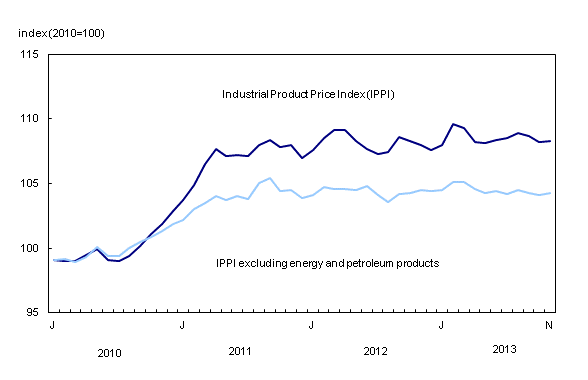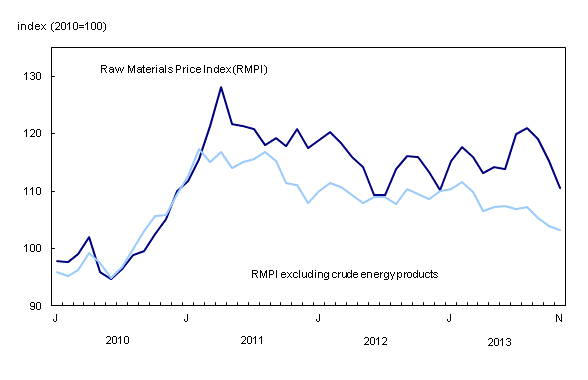Industrial product and raw materials price indexes, November 2013
Archived Content
Information identified as archived is provided for reference, research or recordkeeping purposes. It is not subject to the Government of Canada Web Standards and has not been altered or updated since it was archived. Please "contact us" to request a format other than those available.
Released: 2014-01-06
The Industrial Product Price Index (IPPI) edged up 0.1% in November, mainly because of higher prices for motorized and recreational vehicles. The Raw Materials Price Index (RMPI) fell 4.1%, led by crude energy products.
Industrial Product Price Index, monthly change
The IPPI edged up 0.1% in November, after two consecutive monthly declines. Of the 21 major commodity groups, 15 were up, 2 were down and 4 were unchanged.
Motorized and recreational vehicles (+0.7%) was the main contributor to the increase in the index, primarily as a result of higher prices for passenger cars and light trucks (+0.7%), motor vehicle engines and motor vehicle parts (+0.5%) as well as aircraft (+1.3%). This was the largest increase for the motorized and recreational vehicles group since March 2013.
The advance of the IPPI was also attributable to primary ferrous metal products (+0.9%), specifically basic and semi-finished iron and steel products. In addition, pulp and paper products increased 0.7%, mostly because of higher prices for wood pulp.
Chemicals and chemical products (+0.3%) and electrical, electronic, audiovisual and telecommunication products (+0.3%) also posted price increases in November.
Conversely, the growth of the IPPI was mostly moderated by primary non-ferrous metal products (-0.7%), which registered a third consecutive monthly decline. The decrease was largely attributable to lower prices for unwrought precious metals and precious metal alloys (-1.5%), specifically unwrought silver and silver alloys (-5.3%).
The advance of the IPPI was also moderated by meat, fish, and dairy products (-0.6%), which posted a fourth straight monthly decrease. The downward movement was primarily attributable to lower prices for fresh and frozen pork (-3.3%).
Industrial Product Price Index, 12-month change
The IPPI increased 0.3% in the 12-month period ending in November, after edging down 0.1% in October.
Compared with November 2012, the advance of the IPPI was mainly attributable to energy and petroleum products (+3.3%), which have been rising since June 2013. The increase in this commodity group largely reflected higher prices for motor gasoline (+3.6%), light fuel oils (+8.2%) and diesel fuel (+6.0%). On a year-over-year basis, the IPPI excluding energy and petroleum products fell 0.2%, the same decrease as in October.
In the 12-month period ending in November, motorized and recreational vehicles (+2.2%) also contributed to the increase of the IPPI, mainly as a result of higher prices for passenger cars and light trucks (+1.9%) as well as aircraft (+6.8%). On a year-over-year basis, motorized and recreational vehicles remained on the upward trend that began in July 2013.
Meat, fish, and dairy products (+1.6%) also contributed to the year-over-year increase in the IPPI, mostly because of higher prices for fresh and frozen pork (+13.8%). On a year-over-year basis, meat, fish, and dairy products have not registered a decline in the last three years.
In the 12-month period ending in November, pulp and paper products rose 2.5%, mainly because of higher prices for wood pulp (+4.7%).
The year-over-year increase in the IPPI was moderated mainly by lower prices for primary non-ferrous metal products (-11.1%), specifically unwrought silver and silver alloys. Primary non-ferrous metal products have been declining since December 2011, year over year.
To a lesser extent, fruit, vegetables, feed and other food products (-1.5%) posted a fifth consecutive year-over-year decrease, mainly because of lower prices for animal feed (-7.4%).
Raw Materials Price Index, monthly change
The RMPI fell 4.1% in November, the third consecutive monthly decline. It was also the largest decrease since June 2012. Of the six major commodity groups, four were down, one was up and one was unchanged.
The downward movement of the index was mainly attributable to crude energy products (-7.0%), which posted a third consecutive monthly decrease, primarily as a result of lower prices for conventional crude oil (-7.2%). The sustained growth of North American production was partly responsible for the decline in crude oil prices. The RMPI excluding crude energy products fell 0.7% in November.
To a lesser extent, animals and animal products (-1.8%) also exerted downward pressure on the RMPI, mostly because of lower prices for live animals (-2.6%), specifically hogs (-6.6%). Prices for animals and animal products have been declining since August 2013.
Metal ores, concentrates and scrap (-0.2%) as well as non-metallic mineral products (-0.4%) were also down.
Conversely, crop products (+0.1%) was the only major commodity group to increase in November. This was the first advance for this group since May 2013.
Raw Materials Price Index, 12-month change
The RMPI fell 2.5% in the 12-month period ending in November, after declining 0.6% in October.
On a year-over-year basis, the decrease in the RMPI was mainly attributable to lower prices for metal ores, concentrates and scrap (-9.1%), which have been declining since January 2013.
Crop products (-11.1%) also contributed substantially to the year-over-year decline of the RMPI, mostly because of lower prices for grains (except wheat), particularly corn (-39.2%).
The RMPI decline was moderated in part by animals and animal products (+2.3%), mostly as a result of higher prices for live animals (+4.7%), specifically hogs (+9.9%) and cattle and calves (+7.1%).
Logs, pulpwood, natural rubber and other forestry products (+5.9%) and crude energy products (+0.1%) were also up from November 2012.
Note to readers
With the release of November 2013 data, Statistics Canada converted the Industrial Product Price Index (IPPI) and the Raw Materials Price Index (RMPI) series to 2010=100, with 2010 as the base year. These indexes have also been updated using a weighting pattern based on the 2010 production values of Canadian manufacturers.
At the same time, the classification system was converted to the North American Product Classification System (NAPCS) developed by Canada, the United States and Mexico.
The concordance between the old CANSIM vectors and the new CANSIM vectors is available at the following link: Concordance Table between PCG and NAPCS vectors. For more information, call us (toll-free at 1-800-263-1136; 514-283-8300; infostats@statcan.gc.ca).
With each release, data for the previous six months may have been revised. The indexes are not seasonally adjusted.
The Industrial Product Price Index (IPPI) reflects the prices that producers in Canada receive as the goods leave the plant gate. It does not reflect what the consumer pays. Unlike the Consumer Price Index, the IPPI excludes indirect taxes and all the costs that occur between the time a good leaves the plant and the time the final user takes possession of it, including the transportation, wholesale, and retail costs.
Canadian producers export many goods. They often indicate their prices in foreign currencies, especially in US dollars, which are then converted into Canadian dollars. In particular, this is the case for motor vehicles, pulp, paper and wood products. Therefore, a rise or fall in the value of the Canadian dollar against its US counterpart affects the IPPI. However, the conversion into Canadian dollars only reflects how respondents provide their prices. This is not a measure that takes the full effect of exchange rates into account.
The conversion of prices received in US dollars is based on the average monthly exchange rate (noon spot rate) established by the Bank of Canada, and it is available on CANSIM in table 176-0064 (series v37426). Monthly and annual variations in the exchange rate, as described in the release, are calculated according to the indirect quotation of the exchange rate (for example, CAN$1 = US$X).
The measureable effect of the exchange rate was not calculated with the release of November 2013 data. Additional analysis is required to derive the new conversion factor based on the 2010 weighting pattern and the new NAPCS classification. Once the new factor has been determined, the measureable effect of the exchange rate on the IPPI will be calculated. It is anticipated that this will be included in the release of December 2013 data.
The Raw Materials Price Index (RMPI) reflects the prices paid by Canadian manufacturers for key raw materials. Many of those prices are set on the world market. However, as few prices are denominated in foreign currencies, their conversion into Canadian dollars has only a minor effect on the calculation of the RMPI.
Table CANSIM table329-0074: Industrial Product Price Index, by major commodity aggregations.
Table CANSIM table329-0075: Industrial Product Price Index, by commodity.
Table CANSIM table329-0076: Industrial Product Price Index, for selected groups, by region.
Table CANSIM table329-0077: Industrial Product Price Index, by North American Industry Classification System.
Table CANSIM table330-0008: Raw Materials Price Index, by commodity.
Definitions, data sources and methods: survey numbers survey number2306 and survey number2318.
The industrial product and raw materials price indexes for December 2013 will be released on February 3.
Contact information
For more information, or to enquire about the concepts, methods or data quality of this release, contact us (toll-free 1-800-263-1136; 514-283-8300; infostats@statcan.gc.ca) or Media Relations (613-951-4636; statcan.mediahotline-ligneinfomedias.statcan@canada.ca).
- Date modified:



